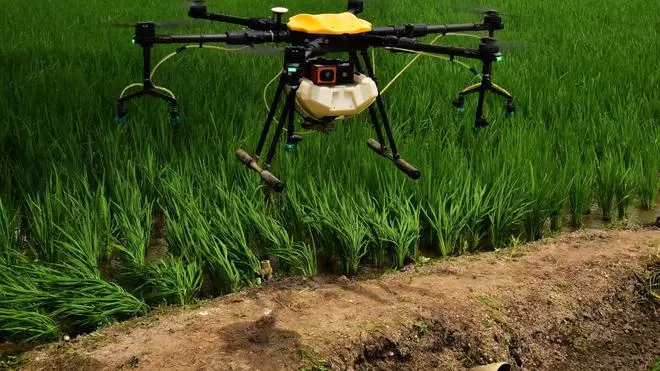Benifits of Drones in agriculture

-
Introduction
- Brief overview of drones in agriculture
- Importance of technological advancements in farming
-
Increased Efficiency with Precision Farming
- Explanation of how drones enhance precision farming
- Examples of specific tasks like crop monitoring and spraying
-
Cost Savings and Resource Optimization
- Discussion on how drones reduce operational costs
- Optimizing the use of fertilizers and pesticides
-
Crop Health Monitoring
- Benefits of using drones for early detection of diseases and pests
- Real-time data for better decision-making in crop management
-
Time-Saving and Rapid Data Collection
- Comparison of traditional methods with drone technology
- Speed and accuracy in data gathering for improved decision-making
-
Environmental Impact
- How drones contribute to sustainable and eco-friendly farming
- Reducing the carbon footprint in agriculture practices
-
Accessibility and Ease of Use
- Discussion on the user-friendly nature of drone technology
- Accessibility for small and large-scale farmers
-
Challenges and Solutions
- Acknowledgment of challenges in adopting drone technology
- Possible solutions and advancements to overcome obstacles
-
Government Support and Regulations
- Overview of regulatory frameworks supporting drone use in agriculture
- Benefits of government initiatives in promoting drone adoption
-
Future Trends in Agricultural Drones
- Discussion on emerging technologies in drone agriculture
- Predictions for the future of drones in farming practices
-
Case Studies
- Real-world examples of successful drone implementation in agriculture
- Impact on crop yield and farmer income
-
Public Perception and Acceptance
- Addressing concerns and misconceptions about agricultural drones
- Highlighting positive outcomes and societal acceptance
-
Integration with Other Technologies
- Exploration of how drones integrate with IoT and AI in agriculture
- Synergy for enhanced farming practices
-
Educational Initiatives and Training
- Importance of educating farmers on drone technology
- Training programs and their role in successful drone integration
-
Conclusion
- Summarizing the key benefits of drones in agriculture
- Encouraging the adoption of this technology for sustainable farming practices
Benefits of Drones in Agriculture
The agricultural landscape is evolving, and technology plays a pivotal role in shaping its future. Among the various technological advancements, drones have emerged as game-changers, particularly in the realm of agriculture. These unmanned aerial vehicles are proving to be indispensable tools for farmers, offering a myriad of benefits that contribute to increased efficiency, cost savings, and sustainable practices.
Increased Efficiency with Precision Farming
Drones have revolutionized precision farming by providing farmers with unparalleled capabilities in monitoring and managing their crops. These aerial devices equipped with advanced sensors can capture high-resolution images, allowing farmers to assess the health of their crops with precision. From identifying areas that require specific attention to optimizing irrigation, drones enhance overall operational efficiency.
Precision Crop Monitoring and Spraying
One of the primary advantages of drones is their ability to monitor crops with a level of detail that was once unimaginable. They can detect early signs of diseases, nutrient deficiencies, or pest infestations, enabling farmers to take corrective measures promptly. Additionally, drones equipped with spraying mechanisms can precisely target affected areas, reducing the need for excessive pesticide use and minimizing environmental impact.
Cost Savings and Resource Optimization
In an era where sustainable farming practices are gaining importance, drones contribute significantly to cost savings and resource optimization. Traditional farming methods often involve blanket applications of fertilizers and pesticides, leading to unnecessary expenses and environmental degradation. Drones, on the other hand, facilitate targeted and efficient use of these resources.
Optimizing Fertilizer and Pesticide Use
Through the integration of drone technology, farmers can analyze the specific needs of their crops and apply fertilizers and pesticides with pinpoint accuracy. This not only reduces costs but also minimizes the ecological footprint associated with excess chemical usage. The result is a more sustainable and environmentally friendly approach to agriculture.
Crop Health Monitoring
One of the critical aspects of successful farming is the ability to monitor crop health effectively. Drones equipped with specialized cameras and sensors provide real-time data on crop conditions, allowing farmers to identify potential issues before they escalate. Early detection of diseases or pest infestations enables prompt intervention, ultimately safeguarding crop yield.
Early Detection of Diseases and Pests
The capability of drones to survey vast expanses of farmland swiftly is invaluable. By detecting diseases or pests at an early stage, farmers can implement targeted measures, preventing the widespread impact that these issues can have on crop production. This proactive approach not only saves crops but also protects the farmer's investment.
Time-Saving and Rapid Data Collection
In the fast-paced world of agriculture, time is a precious commodity. Traditional methods of data collection involve manual labor and can be time-consuming. Drones revolutionize this process by providing rapid and accurate data collection, significantly reducing the time and effort required for tasks such as field mapping and surveying.
Comparison with Traditional Methods
Consider the contrast between walking through a field for inspection and deploying a drone to capture comprehensive aerial views. The latter not only saves time but also offers a more detailed and nuanced understanding of the terrain. The speed and efficiency of data collection with drones translate to quicker decision-making for farmers.
Environmental Impact
As the world grapples with the challenges of climate change, sustainable and eco-friendly agricultural practices are imperative. Drones contribute to a reduced environmental impact by minimizing the use of chemicals, optimizing resource utilization, and promoting overall efficiency in farming operations.
Reducing the Carbon Footprint in Agriculture
Traditional agricultural practices often involve heavy machinery, which contributes significantly to carbon emissions. Drones, being lightweight and operated remotely, have a substantially lower carbon footprint. This shift towards more sustainable practices aligns with global efforts to mitigate climate change and promote environmentally responsible farming.
Accessibility and Ease of Use
One of the remarkable aspects of drone technology is its accessibility and ease of use. Initially perceived as high-tech gadgets for large-scale farms, drones have become more affordable and user-friendly, making them accessible to small-scale farmers as well.
User-Friendly Nature of Drone Technology
Modern drones come equipped with intuitive controls and automated features, making them accessible even to those with minimal technical expertise. This democratization of technology ensures that farmers, regardless of the scale of their operations, can harness the benefits of drones in their day-to-day practices.
Challenges and Solutions
While the advantages of agricultural drones are undeniable, their adoption is not without challenges. It's essential to acknowledge these hurdles and explore potential solutions to ensure the widespread and effective integration of drone technology in agriculture.
Overcoming Adoption Challenges
Some challenges include initial investment costs, regulatory hurdles, and concerns about data privacy. However, ongoing advancements in technology, coupled with supportive government policies, are gradually addressing these challenges. Farmers and stakeholders need to be informed and supported during the transition to ensure a smooth and successful adoption of drone technology.
Government Support and Regulations
The role of government support and regulations cannot be overstated in the successful implementation of agricultural drones. Regulatory frameworks that support and facilitate the use of drones in agriculture play a crucial role in encouraging farmers to adopt this transformative technology.
Overview of Regulatory Frameworks
Governments around the world are recognizing the potential of drones in agriculture and are enacting policies that support their responsible use. These frameworks address issues such as licensing, airspace regulations, and data privacy, providing a structured environment for farmers to leverage drone technology without legal uncertainties.
Future Trends in Agricultural Drones
As technology continues to evolve, the future of agricultural drones looks promising. Emerging trends indicate further integration with advanced technologies, enhancing the capabilities and efficiency of these aerial devices in agriculture.
Integration with Advanced Technologies
The synergy between drones, the Internet of Things (IoT), and artificial intelligence (AI) holds immense potential. Drones equipped with AI algorithms can analyze data in real-time, providing actionable insights for farmers. This integration allows for more sophisticated decision-making and further optimization of farming practices.
Case Studies
Real-world examples demonstrate the tangible benefits of integrating drones into agricultural practices. Case studies highlight success stories where drone technology has significantly impacted crop yield, operational efficiency, and overall profitability for farmers.
Impact on Crop Yield and Farmer Income
Examples from various regions showcase how drones have contributed to increased crop yields and, consequently, improved incomes for farmers. These case studies serve as compelling evidence of the positive impact that drone technology can have on the agricultural sector.
Public Perception and Acceptance
Despite the evident advantages of agricultural drones, there may be reservations or misconceptions among the public. Addressing these concerns and fostering positive perceptions are crucial for the widespread acceptance of drone technology in agriculture.
Addressing Concerns and Misconceptions
Common concerns include fears of job displacement and privacy issues. It's essential to communicate that drones are tools that enhance, rather than replace, human labor. Additionally, strict adherence to privacy regulations ensures that data collected by drones is used responsibly and ethically.
Integration with Other Technologies
The future of agriculture lies in the integration of various technologies. Drones, when combined with other cutting-edge technologies like IoT and AI, create a synergistic effect that propels farming practices into a new era of efficiency and sustainability.
Synergy for Enhanced Farming Practices
Imagine a scenario where drones collect data, IoT devices monitor soil conditions, and AI algorithms analyze this information in real-time. The result is a comprehensive and dynamic system that enables farmers to make informed decisions, optimize resource use, and maximize productivity.
Educational Initiatives and Training
For the widespread adoption of agricultural drones, education and training initiatives are paramount. Farmers need to be equipped with the knowledge and skills required to harness the full potential of this technology.
Importance of Education in Drone Technology
Educational programs aimed at farmers provide insights into the benefits and operation of drones. Training initiatives ensure that farmers are not only aware of the technology but also proficient in its use. This empowerment is essential for the successful integration of drones into diverse agricultural practices.
Conclusion
In conclusion, the benefits of drones in agriculture are vast and transformative. From precision farming and cost savings to environmental sustainability and future trends, drones are reshaping the way we approach agriculture. The challenges are real, but with ongoing advancements, supportive government policies, and educational initiatives, the agricultural sector is poised for a technological revolution.
FAQs
-
Are drones only suitable for large-scale farming operations?
- No, modern drones come in various sizes and are suitable for both small and large-scale farming.
-
How do drones contribute to environmental sustainability in agriculture?
- Drones minimize the use of chemicals, reduce carbon emissions, and optimize resource utilization, promoting eco-friendly farming practices.
-
What are the primary challenges in adopting drone technology in agriculture?
- Challenges include initial investment costs, regulatory hurdles, and concerns about data privacy.
-
How can farmers benefit from educational initiatives on drone technology?
- Education and training empower farmers to understand and effectively utilize drone technology for improved farming practices.
-
What role do government regulations play in supporting the use of drones in agriculture?
- Government regulations provide a structured framework, addressing issues such as licensing, airspace regulations, and data privacy, fostering responsible drone use in agriculture.

- Web Development
- Art
- Causes
- Crafts
- Dance
- Drinks
- Film
- Fitness
- Food
- Juegos
- Gardening
- Health
- Home
- Literature
- Music
- Networking
- Other
- Party
- Religion
- Shopping
- Sports
- Theater
- Wellness




